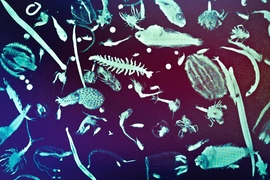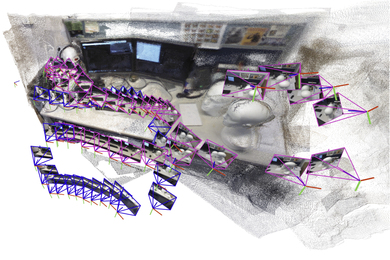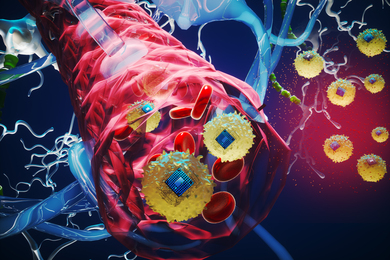In 1930, the deep-sea explorer William Beebe became the first to observe “marine snow,” an ever-present undersea shower of flocculent organic particles composed of dead phytoplankton, zooplankton fecal pellets, and other nutrient-rich detritus. Globally, marine organic particles transport billions of tons of carbon each year from the surface to the deep ocean. The “valves” controlling this carbon flux are none other than microscopic collectives of marine microorganisms, which assemble on and collectively degrade sinking organic particles. However, how marine microorganisms self-assemble into communities on particles, and how these dynamics shape particle degradation, remains unclear.
Microscale microbial community successions
A new study, published recently in Nature Communications and led by MIT graduate student Manoshi S. Datta and MIT Department of Civil and Environmental Engineering (CEE) Professor Otto X. Cordero, in collaboration with professors Martin Polz from CEE and Jeff Gore from the MIT Department of Physics, sheds new light on this area.
Traditionally, it has been difficult to characterize community assembly processes and their drivers on wild marine particles, since these particles can vary widely in age, size, and chemical composition. Therefore, the team used an alternative, “semi-wild” approach, in which they immersed synthetic, chemically defined particles in natural coastal seawater. This approach allowed the team to track the process of community assembly on particles with unprecedented spatiotemporal resolution.
The research shows that microorganisms in the ocean self-assemble into communities on particles through rapid sequential turnover: Certain bacterial taxa attach to and colonize particles, but leave in a matter of hours, only to be replaced by new bacterial taxa. This colonization sequence was surprisingly reproducible and followed a characteristic ecological pattern known as a “primary succession.” At early stages of succession, “pioneers” — bacterial taxa that were adapted to seek out and degrade organic particles — dominated particle-associated communities. However, pioneers paved the way for “secondary consumers,” bacterial taxa that were unable to degrade particles, but could exploit metabolic byproducts from pioneers in order to grow. Interestingly, such primary successions have long been observed in temperate forests. This new study shows that similar ecological dynamics occur within marine microbial communities, but on much shorter temporal (hours) and spatial (microns) scales.
From microscopic dynamics to macroscopic consequences
“Our results suggest that the existing theory of successions that has been developed for plants and animals may be applicable to complex natural microbial communities,” says Cordero, the lead senior author on this work. “This could provide a basis for linking microbial community structure to their population dynamics and activity.”
Furthermore, the research suggests that, through ecological successions, microbial communities on marine particles undergo a major transition, shifting from a collective metabolism dictated by particle nutrients to one determined by the metabolic byproducts of the pioneers. As a result, it is possible that particle-associated communities in the ocean are largely composed of bacteria that cannot degrade the particle, but instead rely on interactions with pioneers in order to survive. “We think these interactions between microbes — where the majority exploits the effort of the pioneer minority — may end up having major effects on carbon turnover in the ocean,” says Cordero, adding that such interactions could shift the balance between organic matter degradation and biomass build-up by microbes in the ocean.
“Microbial ecologists have long asked how microbial communities develop and change over time and if these community dynamics have implications for the way that ecosystems ultimately function,” says Scott Ferrenberg of the United States GS Canyonlands Research Station, who was not involved in the research. “These questions remain at the frontier of microbial ecology. This study is noteworthy for its approach to understanding community development over time and for teasing apart the feeding strategies in these diminutive, yet highly important marine microbes.”
“Our ability to measure microbial communities is just now reaching the point where we can begin to understand interactions among microbes in complex natural environments and the consequences of those interactions at ecosystem scales,” says Senior Research Scientist Stephen Lindemann at the Pacific Northwest National Laboratory, who also did not take part in the study. “This data importantly suggests that close interactions with particle-degrading microbes sustains a high diversity of secondary consumers in marine particle-associated communities. Ultimately, all microbial politics is local, too, and the sheer amount of marine snow means local microbial interactions within these communities may drive carbon cycling at whole-ocean scales.”











